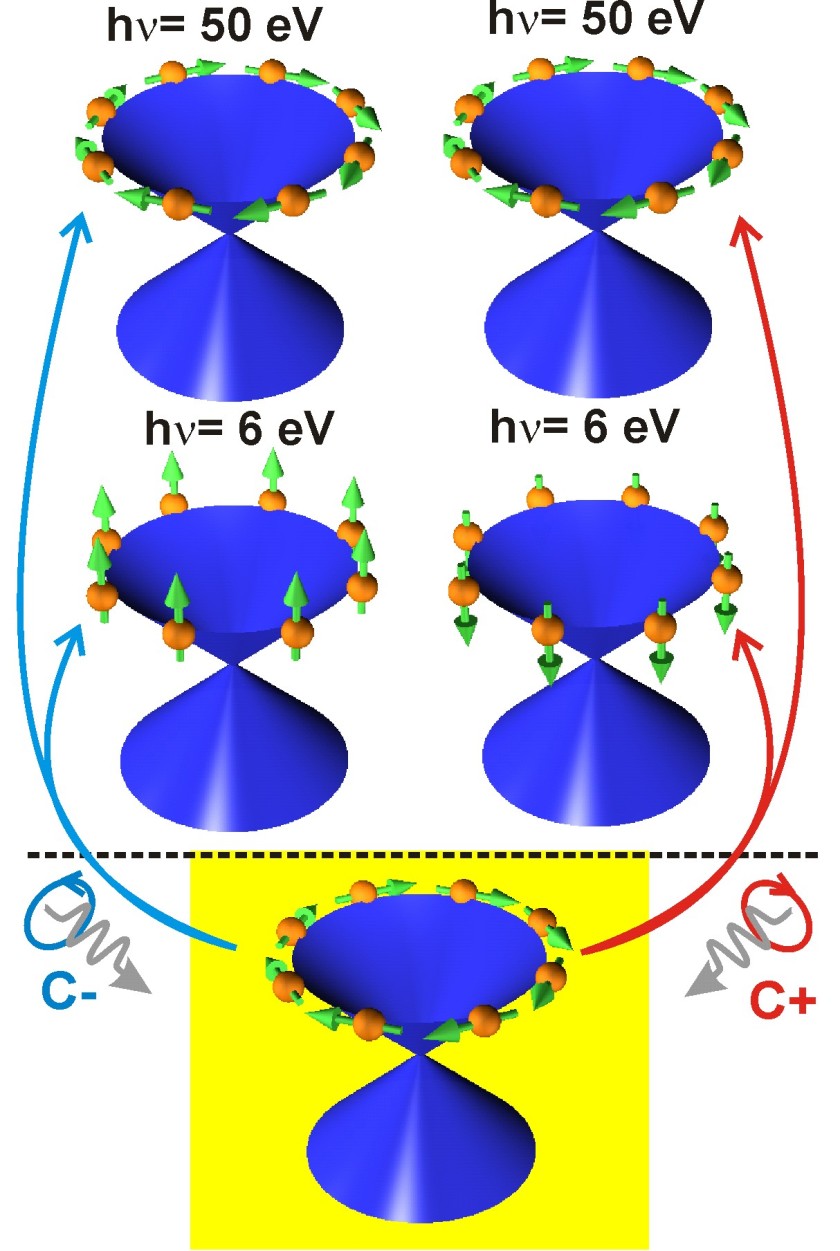How to use light to manipulate the spin in topological insulators

The picture shows the characteristic spin texture (arrows) in a topological insulator and how it is manipulated by circularly polarized light. © Rader/Sachez-Barriga/HZB
Researchers at HZB investigated the topological insulator bismuth selenide (Bi2Se3) by spin-resolved photoelectron spectroscopy at BESSY II. They found an astonishing difference depending on whether it is illuminated by circularly polarized light in the vacuum ultraviolet (50 electron volts, eV) and in the ultraviolet spectral range (6 eV). This result could help explaining how spin currents can be generated in topological insulators.
In the former case, the emitted electrons display the characteristic spin texture of topological insulators, which is aligned on a circle in the surface plane, similarly to a roundabout road sign. In the latter case, however, the spins do not only rotate completely out of this plane but also take on the spin direction imposed by the right or left circularly polarized light.
HZB researchers expect that this manipulation of the electron spin by light and the insight into its preconditions will be most useful for the generation of lossless spin currents in topological insulators.
Topological insulators are a novel state of matter with an insulating bulk and a metallic surface, which are interesting candidates for novel devices in future information technologies. Light-induced spin manipulation is one of the processes involved.The present work reveals the conditions for the generation of dissipationless spin currents in topological insulators.
Their results have just been accepted for publication in Physical Review X, the new top journal of the Americal Physical Society.
OR
https://www.helmholtz-berlin.de/pubbin/news_seite?nid=13928;sprache=en
- Copy link
-
New instrument at BESSY II: The OÆSE endstation in EMIL
A new instrument is now available at BESSY II for investigating catalyst materials, battery electrodes and other energy devices under operating conditions: the Operando Absorption and Emission Spectroscopy on EMIL (OÆSE) endstation in the Energy Materials In-situ Laboratory Berlin (EMIL). A team led by Raul Garcia-Diez and Marcus Bär showcases the instrument’s capabilities via a proof-of-concept study on electrodeposited copper.
-
Green hydrogen: A cage structured material transforms into a performant catalyst
Clathrates are characterised by a complex cage structure that provides space for guest ions too. Now, for the first time, a team has investigated the suitability of clathrates as catalysts for electrolytic hydrogen production with impressive results: the clathrate sample was even more efficient and robust than currently used nickel-based catalysts. They also found a reason for this enhanced performance. Measurements at BESSY II showed that the clathrates undergo structural changes during the catalytic reaction: the three-dimensional cage structure decays into ultra-thin nanosheets that allow maximum contact with active catalytic centres. The study has been published in the journal ‘Angewandte Chemie’.
-
Solar cells on moon glass for a future base on the moon
Future settlements on the moon will need energy, which could be supplied by photovoltaics. However, launching material into space is expensive – transporting one kilogram to the moon costs one million euros. But there are also resources on the moon that can be used. A research team led by Dr. Felix Lang of the University of Potsdam and Dr. Stefan Linke of the Technical University of Berlin have now produced the required glass from ‘moon dust’ (regolith) and coated it with perovskite. This could save up to 99 percent of the weight needed to produce PV modules on the moon. The team tested the radiation tolerance of the solar cells at the proton accelerator of the HZB.
